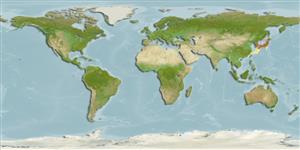Environment: milieu / climate zone / depth range / distribution range
Ecología
marino demersal; rango de profundidad 152 - 269 m (Ref. 27311). Temperate
Distribución
Países | Áreas FAO | Ecosistemas | Ocurrencias, apariciones | Point map | Introducciones | Faunafri
Northwest Pacific: off the Pacific coast of Japan.
Tamaño / Peso / Age
Maturity: Lm ? range ? - ? cm
Max length : 21.2 cm SL macho / no sexado; (Ref. 27311)
Short description
Claves de identificación | Morfología | Morfometría
Espinas dorsales (total) : 12 - 14; Radios blandos dorsales (total) : 8 - 10; Espinas anales: 0; Radios blandos anales: 16 - 18. Lower jaw projecting forward beyond upper one. Snout never tubular. Branchial membranes free from isthmus. Many small bony plates on subpectoral region.
Life cycle and mating behavior
Maturities | Reproducción | Spawnings | Egg(s) | Fecundities | Larva
Masuda, H., K. Amaoka, C. Araga, T. Uyeno and T. Yoshino, 1984. The fishes of the Japanese Archipelago. Vol. 1. Tokai University Press, Tokyo, Japan. 437 p. (text). (Ref. 559)
IUCN Red List Status (Ref. 130435)
Threat to humans
Harmless
Human uses
Herramientas
Special reports
Download XML
Fuentes de Internet
Estimates based on models
Preferred temperature (Ref.
123201): 1.8 - 16.3, mean 6.1 °C (based on 14 cells).
Phylogenetic diversity index (Ref.
82804): PD
50 = 0.5625 [Uniqueness, from 0.5 = low to 2.0 = high].
Bayesian length-weight: a=0.00389 (0.00180 - 0.00842), b=3.12 (2.94 - 3.30), in cm total length, based on all LWR estimates for this body shape (Ref.
93245).
Nivel trófico (Ref.
69278): 3.2 ±0.3 se; based on size and trophs of closest relatives
Resiliencia (Ref.
120179): Medio, población duplicada en un tiempo mínimo de 1.4-4.4 años (Preliminary K or Fecundity.).
Fishing Vulnerability (Ref.
59153): Low vulnerability (16 of 100).
